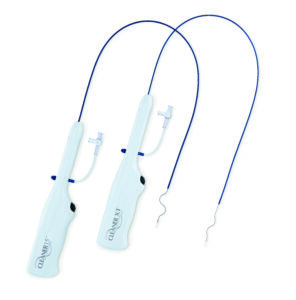This advertorial is sponsored by Argon Medical.

The CLEANER Rotational Thrombectomy system (Argon Medical) used for arteriovenous fistula and grafts seeks to provide interventionalists with an all-in-one tool to treat a range of percutaneous thrombectomy cases. This is according to general surgeon Jason Beaver (Surgery Center South, Dothan, USA) and interventional radiologist Amr Elsaadany (Barts Health NHS Trust, London, UK), who discuss their experiences macerating organised or difficult-to-access thrombus with the device.
The CLEANER device is indicated for the mechanical declotting of native vessel dialysis fistulae, synthetic dialysis access grafts, and peripheral vasculature. Additionally, the device can be used for controlled and selective infusion of physician-specified fluids in the peripheral vasculature. It works via a self-sizing sinusoidal wire that rotates at 4,000 rpm, breaking apart wall-adherent thrombus. This design creates a fluid vortex that forces clot burden to macerate into small particles without causing endothelial damage and has had proven success in patients with pseudoaneurysms and stents .
Procedurally, Elsaadany notes that one of the most “challenging” elements of native AV fistula treatment is the tortuosity of the vessel—especially with long-standing fistulas with aneurysmal dilatation. He adds that challenges also arise due to pseudoaneurysms, as these can often contain thrombi of different ages, from acute to sub-acute and chronic.
“That’s why you need a powerful machine. I usually perform the entire procedure under ultrasound, and, using the CLEANER device, you can massage or compress the rotational wire against the vessel wall,” Elsaadany says. “With its adaptive function, you can ensure that you are going from wall to wall, taking the entire thrombus.”

For Beaver, the adaptability of the system is a key benefit. He believes CLEANER’s self-sizing ability is invaluable when macerating thrombus from a native fistula. Eliminating this thrombus can be challenging, as an inflammatory response can be triggered when the vein clots, creating a more organised, rubbery, defined clot. With the CLEANER device, labelling it the ‘Keep it Cleaner’ system, Beaver asserts that the “appropriately aggressive” rotational function allows for safe and effective thrombus maceration in the first instance. “With other devices, the fistula can often re-clot sooner,” he says.
“The CLEANER device helps you get a large percentage of the clot out quickly, re-establishing flow,” Beaver adds. In doing so, he has seen fewer patients needing a secondary thrombectomy two or three days following the initial procedure. This, he believes, is the effect of the CLEANER device, which provides “more comprehensive clot clearance from the access.”
Continuing, Elsaadany and Beaver agree that macerating clot efficiently minimises procedural time. “Having used several mechanical thrombectomy devices,” Elsaadany states, “the CLEANER device has provided the most efficiency. Graft cases should not take more than 20–30 minutes. Having a patient in your angio suite for over an hour will restrict the number of patients you can treat daily. The CLEANER device, in my experience, provides a higher level of efficiency.”
Particularly in dialysis patients, Beaver notes that streamlining procedures with the CLEANER system is important to minimise time “on the table” and decrease the disruption to the patient’s regularly scheduled treatment and their daily lives. “The device helps to improve procedure times,” he says. “I’m big on not keeping these dialysis patients on the table longer than they need to be, and I can usually do a straightforward declot in around 10–15 minutes. Efficiency-wise, the CLEANER device helps tremendously.”
Selecting patients for mechanical thrombectomy can be complex. Beaver points out, “Often we are working with a patient population that is very frail, with several comorbidities.” For this reason, complication rates are paramount when selecting a device. For difficult cases, such as those involving large, dilated fistulas, Beaver explains that he first injects alteplase to dissolve some of the clot before using the CLEANER device to ensure a more successful outcome.
Elsaadany agrees that careful patient selection is necessary when planning a mechanical thrombectomy. He details that, when using a thrombolytic agent, the three-way infusion port of the CLEANER device effectively delivers the injection to the patient. Alternatively, Elsaadany highlights his recent experience using the device without a thrombolytic agent in cases where it may be risky, noting that these procedures have been successful.
“Before choosing the most appropriate equipment for a procedure and patient, you will ask yourself— which tool has the potential to cause the fewest complications?” Elsaadany says. In his experience, the CLEANER device has reduced side-effects in his patients undergoing thrombectomy, mainly due to its “atraumatic” tip and rotational wire. “There’s no risk for any perforation or injury to the vessel wall as it macerates the thrombus into minute parts, which also means there is little to no concern about pulmonary embolism [PE],” Elsaadany states.
Citing the risk of PE, Beaver underlines the importance of macerating the entire clot while reducing procedure time to improve patient outcomes. He states this can be helped by combining visualisation techniques with the CLEANER device during thrombectomy procedures. The system’s compatibility with the latest imaging and fluoroscopy technology allows visualisation of the thrombus and surrounding vasculature in real time to ensure interventionalists can make informed decisions and monitor the procedure’s progress. “If you’re de-clotting an access in which you aren’t sure which side is the venous and which is the arterial,” he details, “you can go across with the CLEANER device, inject some contrast and figure out which side you are on—that’s a nice bonus.”
Summing up, Elsaadany reflects that: “The dialysis fistula is the lifeline of chronic kidney disease patients. We need equipment that is fast, efficient, and powerful and that reduces clot recurrence rates which I have seen with the CLEANER device.” To this, Beaver agrees, noting that since moving to CLEANER, he has provided safer and more effective treatment, seeing fewer patients returning re-clotted for a repeat procedure. Using CLEANER for a “multitude” of thrombectomy cases, Beaver attests to the device’s “versatility across a spectrum of indications” and ability to optimise mechanical thrombectomy procedures for the benefit of patients and physicians.
References:
- Vega, F. Safety Comparison of Cleaner™ Rotational Thrombectomy System Versus Arrow PTDTM in Native Vessel. San Carlos, CA: Isis Services, LLC; 2010.
- Webb A, Zacharias K, et al. Dialysis Shunt Thrombectomy Utilizing a Rotational Thrombectomy Device in Patients with Pseudoaneurysms. The Arab Journal of Interventional Radiology. 2020;4(02):87-91. https://doi. org/10.1055/s-0041-1729018).https://doi.org/10.1055/s-0041-1729018).










